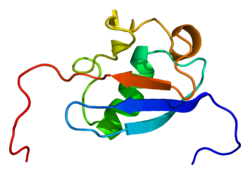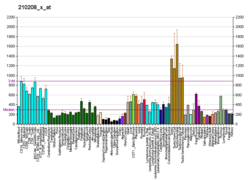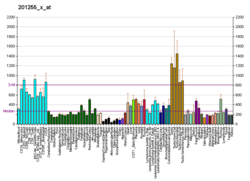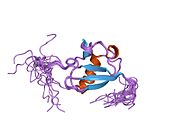| BAG6 |
|---|
 |
| Available structures |
|---|
| PDB | Ortholog search: PDBe RCSB |
|---|
| List of PDB id codes |
|---|
1WX9, 4DWF, 4EEW, 4WWR, 4X86, 2N9P |
|
|
| Identifiers |
|---|
| Aliases | BAG6, BAG-6, BAT3, D6S52E, G3, HLA-B associated transcript 3, BCL2 associated athanogene 6, BAG cochaperone 6 |
|---|
| External IDs | OMIM: 142590; MGI: 1919439; HomoloGene: 3409; GeneCards: BAG6; OMA:BAG6 - orthologs |
|---|
| Gene location (Human) |
|---|
 | | Chr. | Chromosome 6 (human)[1] |
|---|
| | Band | 6p21.33 | Start | 31,639,028 bp[1] |
|---|
| End | 31,652,705 bp[1] |
|---|
|
| Gene location (Mouse) |
|---|
 | | Chr. | Chromosome 17 (mouse)[2] |
|---|
| | Band | 17 B1|17 18.59 cM | Start | 35,135,178 bp[2] |
|---|
| End | 35,147,322 bp[2] |
|---|
|
| RNA expression pattern |
|---|
| Bgee | | Human | Mouse (ortholog) |
|---|
| Top expressed in | - right testis
- left testis
- right lobe of thyroid gland
- right uterine tube
- apex of heart
- pituitary gland
- ganglionic eminence
- left lobe of thyroid gland
- anterior pituitary
- muscle of thigh
|
| | Top expressed in | - seminiferous tubule
- spermatid
- spermatocyte
- neural layer of retina
- ventricular zone
- muscle of thigh
- superior frontal gyrus
- dentate gyrus of hippocampal formation granule cell
- yolk sac
- lip
|
| | More reference expression data |
|
|---|
| BioGPS | 

 | | More reference expression data |
|
|---|
|
| Gene ontology |
|---|
| Molecular function | - ribosome binding
- misfolded protein binding
- Hsp70 protein binding
- polyubiquitin modification-dependent protein binding
- proteasome binding
- protein binding
- ubiquitin-specific protease binding
- ubiquitin protein ligase binding
- signaling receptor binding
- identical protein binding
| | Cellular component | - cytoplasm
- cytosol
- membrane
- intracellular membrane-bounded organelle
- nucleoplasm
- BAT3 complex
- nucleus
- extracellular region
- extracellular exosome
| | Biological process | - regulation of apoptotic process
- negative regulation of proteolysis
- intrinsic apoptotic signaling pathway in response to DNA damage by p53 class mediator
- cell differentiation
- ubiquitin-dependent protein catabolic process
- kidney development
- embryo development
- lung development
- immune system process
- positive regulation of ERAD pathway
- protein stabilization
- negative regulation of apoptotic process
- internal peptidyl-lysine acetylation
- brain development
- intrinsic apoptotic signaling pathway in response to endoplasmic reticulum stress
- regulation of cell population proliferation
- synaptonemal complex assembly
- spermatogenesis
- negative regulation of proteasomal ubiquitin-dependent protein catabolic process
- protein localization to cytosolic proteasome complex involved in ERAD pathway
- maintenance of unfolded protein involved in ERAD pathway
- tail-anchored membrane protein insertion into ER membrane
- ER-associated misfolded protein catabolic process
- immune response-activating cell surface receptor signaling pathway
- apoptotic process
- natural killer cell activation
- proteasomal protein catabolic process
- ubiquitin-dependent ERAD pathway
- endoplasmic reticulum stress-induced pre-emptive quality control
- transport
- chromatin organization
- proteasome-mediated ubiquitin-dependent protein catabolic process
- regulation of embryonic development
| | Sources:Amigo / QuickGO |
|
| Orthologs |
|---|
| Species | Human | Mouse |
|---|
| Entrez | | |
|---|
| Ensembl | ENSG00000204463
ENSG00000228760
ENSG00000234651
ENSG00000229524
ENSG00000096155
|
|---|
ENSG00000227761
ENSG00000233348 |
| |
|---|
| UniProt | | |
|---|
| RefSeq (mRNA) | NM_001098534
NM_001199697
NM_001199698
NM_004639
NM_080702
|
|---|
NM_080703 |
| |
|---|
NM_001252468
NM_001252469
NM_057171 |
|
|---|
| RefSeq (protein) | |
|---|
NP_001092004
NP_001186626
NP_001186627
NP_542433
NP_542434 |
| NP_001239397
NP_001239398
NP_476512
NP_001359189
NP_001359190
|
|---|
NP_001359191
NP_001359194
NP_001359195
NP_001359196
NP_001359197
NP_001359198
NP_001359199
NP_001359200
NP_001359201
NP_001359202
NP_001359203
NP_001359204
NP_001359205
NP_001359206
NP_001359207
NP_001359208
NP_001359209
NP_001359210
NP_001359211
NP_001359212
NP_001359213
NP_001359214
NP_001359215
NP_001359216
NP_001359217
NP_001359218
NP_001359219
NP_001359220
NP_001391257
NP_001391258
NP_001391259
NP_001391260
NP_001391256 |
|
|---|
| Location (UCSC) | Chr 6: 31.64 – 31.65 Mb | Chr 17: 35.14 – 35.15 Mb |
|---|
| PubMed search | [3] | [4] |
|---|
|
| Wikidata |
| View/Edit Human | View/Edit Mouse |
|

 1wx9: Solution Structure of the N-terminal Ubiquitin-like Domain in the Human BAT3 Protein
1wx9: Solution Structure of the N-terminal Ubiquitin-like Domain in the Human BAT3 Protein





















